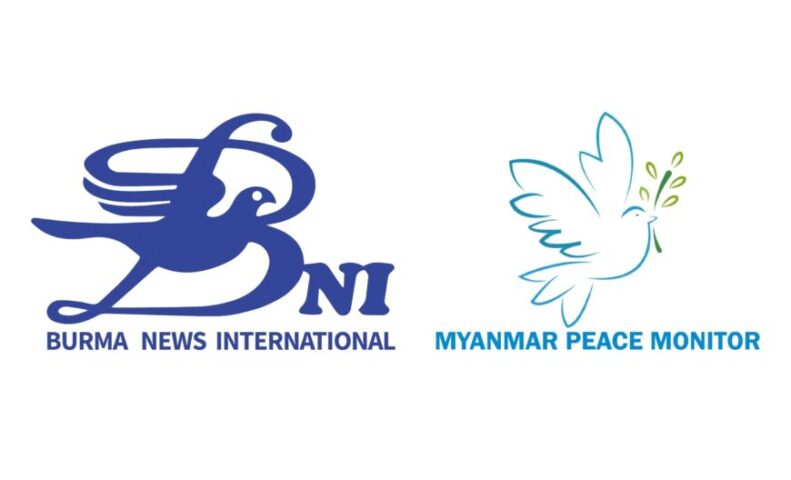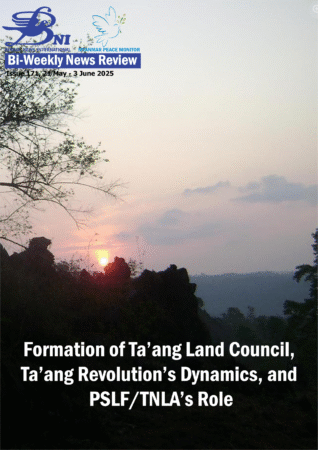
Introduction
The Ta’ang Political Consultative Committee (TPCC), an active player since the start of the Spring Revolution, has evolved into the Ta’ang Land Council (TLC), now the highest political authority of the Ta’ang revolution. The TPCC plans to establish a Ta’ang people’s revolutionary government within six months in areas liberated from the military junta. It has also pledged to work with other resistance groups in Myanmar to create a federal union.
This issue of Burma News International (BNI)-Myanmar Peace Monitor’s Bi-Weekly News Review looks into the formation of the Ta’ang Land Council, the dynamics of the Ta’ang revolution, and the role of the Palaung State Liberation Front/Ta’ang National Liberation Army (PSLF/TNLA).
Formation of the Ta’ang Land Council
From 1-3 June 2025, the TPCC held a high-level political meeting attended by 83 representatives, including top leaders from the Ta’ang (Palaung) National Party (TNP), the Palaung State Liberation Front/Ta’ang National Liberation Army (PSLF/TNLA), and Ta’ang Civil Society Organizations (TCSOs). During the meeting, the Ta’ang State Constitution Drafting Committee (TSCDC) presented the “Ta’ang Revolutionary Government Plan,” which was approved. The attendees also resolved to establish the Ta’ang Land Council (TLC) as the highest political authority during the Ta’ang revolutionary period.
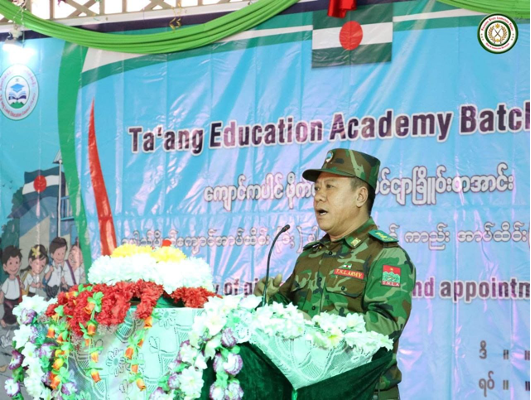
The TPCC, originally formed on 24 March 2021, has now been transformed into the TLC, with the aim of overseeing and guiding the three pillars of the Ta’ang State: executive, legislative, and judicial. The TLC is chaired by General Tar Aik Bong, the leader of PSLF/TNLA. Lway Moe Kham from Ta’ang Civil Society Organizations serves as the Vice-Chair 1, while Tar Aye Maung from the Ta’ang (Palaung) National Party holds the position of Vice-Chair 2. The TLC comprises nine council members, with three representatives each from the aforementioned three groups. Notably, the council includes four women and five men, highlighting the significant role of women’s leadership within the council.
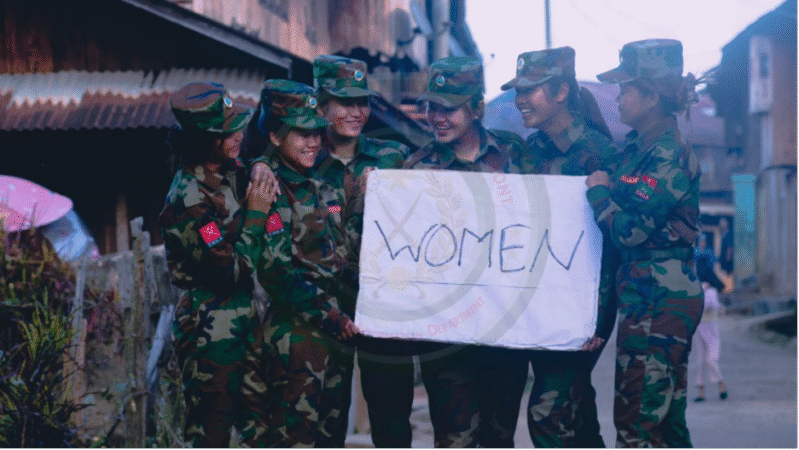
In 2025, the Ta’ang Land Council (TLC) plans to establish a Ta’ang people’s government, comprising leaders from its three constituent groups and other appropriate representatives. Simultaneously, it aims to collaborate with resistance forces across Myanmar to build a federal democratic union.
Mai Naing Gaung Zar, Secretary of the Ta’ang National Consultative Council (TNCC), stated that the TLC has more authority than the TPCC, and the TLC will continue to participate under its name in all groups and areas where the TPCC has been involved in the Spring Revolution. He further explain that as the TLC has been elevated to the highest authority, it will take the lead in discussing and deciding on cooperative initiatives and processes with emerging resistance forces or other allied groups during the Spring Revolution. 1
Currently, the TPCC is an active member of the National Unity Consultative Council (NUCC) and has a representative serving as a deputy minister in the National Unity Government’s (NUG) Ministry of Federal Union Affairs. In line with the guidelines of the Committee Representing Pyidaungsu Hluttaw (CRPH), the TPCC has also established an interim Ta’ang regional people’s administration body.
The TNCC is also included in the Statement (01/2025) issued on 12 February 2025, by Ethnic Revolutionary Organizations and Federal Councils Representing States/Nationalities. It states that they will practically build and implement a future federal democratic union through a “Bottom-up Federalism Approach,” emphasizing “strong states as a foundation for a robust union.”
This approach includes the TPCC along with the Karenni National Progressive Party (KNPP), Karen National Union (KNU), Chin National Front (CNF), New Mon State Party (Anti-Dictatorship) (NMSP-AD), Karenni State Consultative Council (KSCC), Pa-O National Federal Council (PNFC), Mon State Federal Council (MSFC), and the Women’s League of Burma (WLB).
In essence, the formation of the TLC, uniting military, political, and civil society forces, clearly demonstrates its leadership and direction. It also prominently showcases the Ta’ang region’s revolutionary/military and political dynamics.
Ta’ang Revolution’s Dynamics and PSLF/TNLA’s Role
The most immediate and visible shift in the Ta’ang revolution is “Operation1027,” which began on 27 October 2023. During this operation, the Palaung State Liberation Front/Ta’ang National Liberation Army (PSLF/TNLA) played a leading role alongside two other members of the Three Brotherhood Alliance. Simultaneously, the PSLF/TNLA coordinated with People’s Defense Forces/Local Defense Forces (PDFs/LDFs) that emerged during the Spring Revolution, taking a leadership role in launching offensives against the military junta’s forces.
During the first and second phases of Operation 1027, the PSLF/TNLA seized control of 12 towns from the military junta, including Monglon, Namhsan, Namkham, Mantong, Namtu, Mongngawt, Kutkai, Nawngkhio, Moemeik, Kyaukme, Hsipaw, and Mogok. Despite ongoing negotiations with junta representatives, facilitated by the Chinese government, the PSLF/TNLA appears determined not to return the towns and territories it has seized from the military junta.
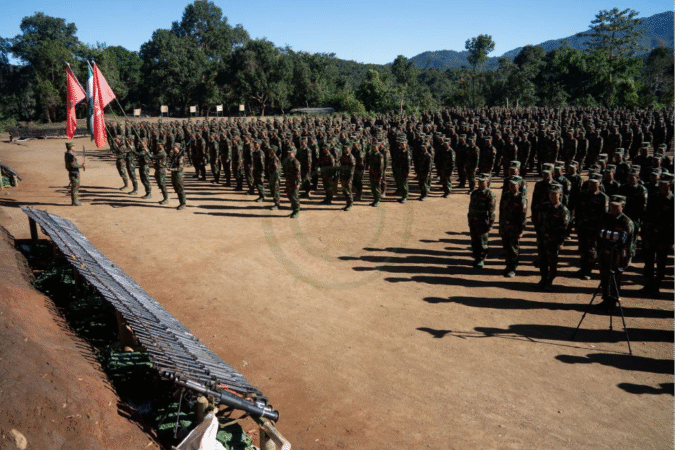
The PSLF/TNLA has now demonstrated its leadership role within the Ta’ang Land Council (TLC). As the Ta’ang revolutionary period progresses toward establishing a people’s government, the PSLF/TNLA’s leadership is expected to be prominently visible, working alongside leaders from other political and civil society organizations.
Similarly, PSLF/TNLA continues to play a significant role in the Federal Political Negotiation and Consultative Committee (FPNCC), which comprises seven ethnic armed organizations, as well as in the Three Brotherhood Alliance. Furthermore, the PSLF/TNLA has been actively involved in coordinated efforts with PDFs/LDFs and with regional allied operations.
Review
Fighting continues to intensify in Nawnghkio Township, which is under the control of the PSLF/TNLA. The military junta is attempting to regain lost territories with the help of the Chinese government, and militarily, it is exerting pressure with both ground and air offensives. Meanwhile, there has been an increase in the dissemination of propaganda aimed at sowing discord between the PSLF/TNLA and its resistance allies in the region.
The formation of the Ta’ang Land Council (TLC), uniting political organizations, civil society groups, and armed resistance groups within the Ta’ang region, marks a significant shift in the Ta’ang revolution. However, challenges abound, including ethnic tensions in the region, pressure from the Chinese government, and junta airstrikes, all of which pose substantial hurdles for the TLC.
Nevertheless, the leadership role of the PSLF/TNLA in the Ta’ang Land Council, which has emerged as the highest authority during the Ta’ang revolution, is highly noteworthy. It remains to be seen whether it will become a revolutionary force for building a future federal democratic union.
The formation of the TLC can be considered a critical step towards the ” strong states as a foundation for a robust union ” approach. It can also be seen as a vital precursor to broader military and political shifts and to steps towards dismantling all forms of authoritarianism, including the military dictatorship.
1 “Rather than the leadership of PSLF/TNLA, all authority has been given to the TLC.” — Burma VJ, 9 June 2025
